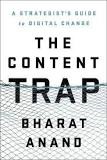 If I value a book section based on the number of pages I have highlighted, the winner would be Part IV of the Content Trap, which rightfully advances and supports the points made previously with both evidence and conclusions.
If I value a book section based on the number of pages I have highlighted, the winner would be Part IV of the Content Trap, which rightfully advances and supports the points made previously with both evidence and conclusions.
Dr. Bharat Anand starts this concluding section by discussing early predictions that targeting, measurement, and interactivity would dramatically improve Internet advertising. All those predictions were wrong. Click-through rates for most ads average 0.1%. Advertisers remain unable to determine an accurate ROI. Marketing executives are unable to determine if their digital advertising campaigns are worth it. The assumptions made that more people looking at ads would translate into better ad effectiveness were wrong.
Before you can figure out how advertising works, you have to understand whether it works. The fact that someone buys a product may have nothing to do with whether or not the buyer was exposed to a product ad. Advertisers target specific consumer groups and seek media channels where they are most likely to find their desired consumers. Dr. Anand identifies this as the endogeneity problem and states that the question to solve is, “does advertising exposure lead to product purchase, or do consumer preferences result in both ad exposure and product purchase?” He discusses an exercise performed by eBay by which they tried to separate the effects of paid and organic searches. They concluded that paid searches using your brand are essentially a waste of money and, as a result, stopped bidding for the keyword eBay.
Anand discusses the utilization of CMSs (content management systems) as tools to effect user-centered marketing. CMSs are used by organizations to “upload, display, organize, store, and manipulate content on their websites.” The Huffington Post, for example, was one of the first organizations to use its CMS as a tool to drive traffic around search and social media to directly connect content with conversation. By doing so, they found that it was a great tool to track ad performance.
Crowdsourcing creative is another form of user-centered marketing, as are partnering and co-creation. Getting consumers to like your advertising is one advancement, and getting them to like your product is another step up, but best of all is when they tell others about it. The latter, viral advertising, is an expression of user connections. Buzzfeed is another one of the most successful businesses that built itself virally. Connections are about making people connect; get the first part right before you attempt to sell into your connections.
According to Anand, advertising today is consumed by three questions: how to reach more eyeballs at the lowest cost, how to preserve ad revenue in a world of falling ad prices, and what new metrics to use in a world of digital advertising, social media, and hypertargeting. Each of these questions and the traditional mindset form the Content Trap. The premise of modern and effective advertising is about sharing, networks, and communities. Conducting an effective campaign can only come from understanding user connections. Management teams need to understand how the economics of any business change when the business becomes another product or company’s complement. That understanding comes from recognizing product connections.
Anand notes that companies that understand product needs, context, and strengths should create a network effect around the product, and users will become advertisers through viral campaigns. The real tension in advertising and marketing is not between traditional and digital; it’s between product- and user-centered thinking. Great campaigns create authenticity, user-centricity, and consumer trust. It is important to understand the connections between brands and users and between users themselves. Companies that can manage the connections will succeed.
The remainder of Part IV details the author’s experience creating HBX, Harvard Business School’s first online offering, which involved transforming its pre-MBA courses the summer before matriculation into online courses. For those in the education field facing similar challenges about what part of the curriculum should go online and how to do it, these chapters are worthwhile reading.
When I pen a book review, I typically write a couple of pages about a few key concepts and whether I recommend it. I have so much to say about The Content Trap that I split my review into five parts, just to break up the comments and provide a little more understanding of key concepts. Perhaps I enjoyed reading it because so many of the concepts and tactics discussed are within the capabilities of an online post secondary education institution like APUS. Or, maybe it was because I’ve been an avid observer of, and commentator on, business models throughout my career and recognize that mastering these concepts can make a difference in the scalability and success of a business in the digital era. It’s most likely because Bharat Anand provided the missing link for me between content and successful products. It’s the connections! Let me know your thoughts after you read it!
*Author’s note: Unless otherwise noted, the factual observations and images included herein are the intellectual property of Dr. Bharat Anand and/or Random House Publishing Group.











